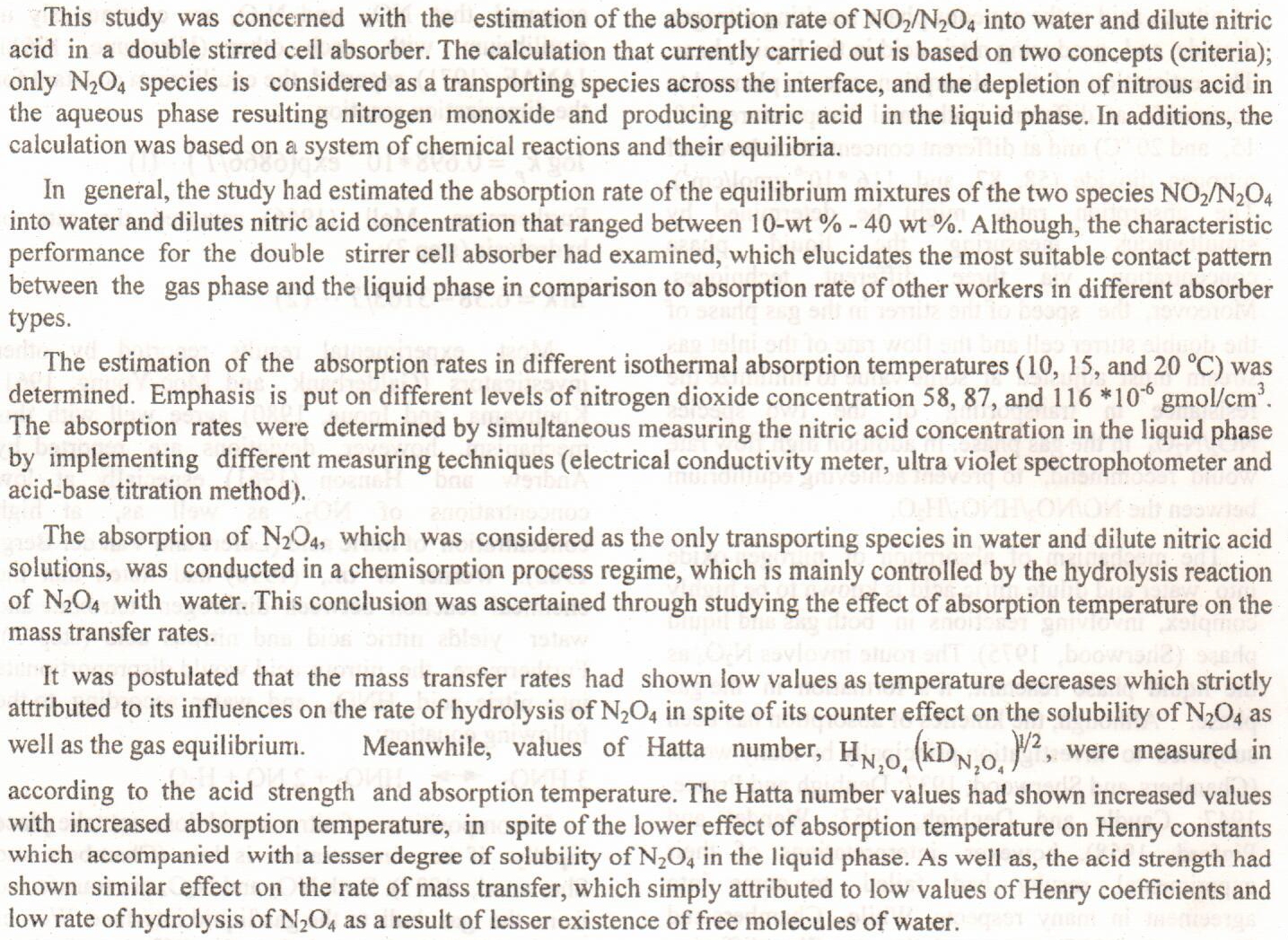
In this publication, several six coordinate Co(III)-complexes are reported. The reaction of 2,3-butanedione monoxime with ethylenediamine or o-phenylenediamine in mole ratios of 2:1 gave the tetradentate imine-oxime ligands diaminoethane-N,N`-bis(2-butylidine-3-onedioxime) H2L1 and o-phenylenediamine-N,N`-bis(2-butylidine-3-onedioxime), respectively. The reaction of H2L1 and H2L2 with Co(NO3)2, and the amino acid co-ligands (glycine or serine) resulted in the formation of the required complexes. Upon complex formation, the ligands behave as a neutral tetradantate species, while the amino acid co-ligand acts as a monobasic species. The mode of bonding and overall geometry of the complexes were determined through physico-chemical and spectro
... Show MoreElectrocoagulation process was employed for the treatment of river water flows in Iraq. In this study, a batch Electrocoagulation process was used to treat river water taken from Al - Qadisiyah water treatment plant. electrolysis time, voltage and inter-electrode spacing were the most important parameters to study . A statistical model was developed using the RSM model. The optimum condition after studying the parameter effect the process was 1 cm separating, 30 volts . The RSM model shows the ideal condition of removal for both the TSS and turbidity at 1 cm, 20 volts and 55 min.
 (1)
(1)
 (1)
(1)
Abstract. Shock chlorination is a well-known practice in swimming pools and domestic wells. One of the limitations for using this technique in drinking water purification facilities is the difficulty of quickly removing high chlorine concentrations in water distribution systems or production facilities. In order to use this method in the drinking water industry a shock de-chlorination method should be introduced for producing microorganism and biocide free water. De-chlorination using natural stagnant aeration (leaving the water to lose the chlorine naturally) is the safest known method if compared with chemical and charcoaling methods. Unfortunately, stagnant aeration is a slow process. Therefore, developing a process for accelerat
... Show More (2)
(2)
Abstract. The main technique for removing bacteria from water for various applications is chemical disinfection. However, this method has many disadvantages such as producing disinfectant by-products (DBPs), biofilm formation and either rendering the water unpotable (at high residual disinfection) or leaving a potential for lethal diseases such as Cholera (if the residual disinfection is too low). Recently, a process was developed for continuous removal of bacteria from water using the principle of froth flotation through compressed air only without any chemicals (Hassan, 2015). This work examines the extent to which chemical free froth flotation can purify drinking water. The experiments were carried out using two flotation columns
... Show MoreCrude soybean peroxidase (SBP), isolated from soybean seed coats (hulls) at unusually low concentrations, catalyses the oxidative polymerisation of hazardous aqueous benzidine and its 3,3′-dichloro, 3,3′-dimethyl and 3,3′-dimethoxy derivatives in the presence of hydrogen peroxide. The optimum operating conditions for oxidation of 0·10 mM benzidine were investigated. At pH 5, the hydrogen peroxide-to-substrate concentration ratio was 1·5 and the minimum SBP concentration required to achieve at least 95% conversion of the benzidine in synthetic wastewater was 0·43 mU/ml. Progress curves were established for the conversion of the four substrates, and apparent first-order rate constants were derived. Enzyme-catalysed polym
... Show More (12)
(12)
 (10)
(10)
This study examined the effects of water scarcity on rural household economy in El Fashir Rural Council / North Darfur State- western Sudan. Both quantitative and qualitative methods were used as to get a deeper understanding of the impact of water scarcity on the rural house economy in the study area. 174 households out of 2017 were selected from 45 villages which were distributed in eight village councils forming the study area. Statistical methods were used to manipulate the data of the study. The obtained results revealed that water scarcity negatively affected the rural household economy in the study area in many features. These include the followings: much family efforts and time were directed to fetch for water consequentl
... Show More (1)
(1)
In this study, we fabricated nanofiltration membranes using the electrospinning technique, employing pure PAN and a mixed matrix of PAN/HPMC. The PAN nanofibrous membranes with a concentration of 13wt% were prepared and blended with different concentrations of HPMC in the solvent N, N-Dimethylformamide (DMF). We conducted a comprehensive analysis of these membranes' surface morphology, chemical composition, wettability, and porosity and compared the results. The findings indicated that the inclusion of HPMC in the PAN membranes led to a reduction in surface porosity and fiber size. The contact angle decreased, indicating increased surface hydrophilicity, which can enhance flux and reduce fouling tendencies. Subsequently, we evaluated the e
... Show MoreCoupling reaction of 2-amino benzoic acid with 8-hydroxy quinoline gave bidentate azo ligand. The prepared ligand has been identified by Microelemental Analysis,1HNMR,FT-IR and UV-Vis spectroscopic techniques. Treatment of the prepared ligand with the following metal ions (ZnII,CdII and HgII) in aqueous ethanol with a 1:2 M:L ratio and at optimum pH, yielded a series of neutral complexes of the general formula [M(L)2]. The prepared complexes have been characterized by using flame atomic absorption, (C.H.N) Analysis, FT-IR and UV-Vis spectroscopic methods as well as conductivity measurements. The nature of the complexes formed were studied following the mole ratio and continuous variation methods, Beer's law obeyed over a concentration range
... Show MoreIn this study, the antimicrobial properties of newly synthesized Schiff bases (4a-4e) and thiazolidinone compounds (5a-5e) generated from 3,5-dinitrobenzoic acid were assessed. These compounds were obtained by reacting 3,5-dinitrobenzoic acid (1) with ethanol in a few drops of concentrated H2SO4 to produce the ester (2). The acid hydrazide (3), which was produced by treating the ester with hydrazine hydrate, reacted with the proper aldehydes, including 4-bromobenzaldehyde, 4-chlorobenzaldehyde, 4-hydroxybenzaldehyde, 4-methoxybenzaldehyde, and 4-hydroxy-3-methoxybenzaldehyde, respectively, to form Schiff bases (4a-4e). The thiazolidinone compounds (5a-5e) were produced by the cyclocondensation reaction of compounds (4a-4e) with thio
... Show More
